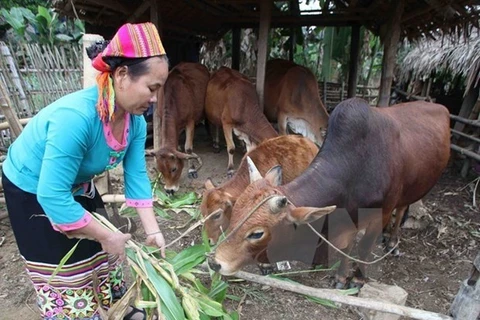 Vegetable cultivation in HCM City’s Cu Chi district has helped reduce poverty in the area (Photo: VNA)
Vegetable cultivation in HCM City’s Cu Chi district has helped reduce poverty in the area (Photo: VNA) HCM City (VNA) - Local authorities need to learn more about the multi-dimensional aspects of poverty and offer solutions to reduce the poverty rate in Ho Chi Minh City, Deputy Secretary of the municipal Party Committee Vo Thi Dung said at a workshop on sustainable poverty reduction held on May 22.
Solutions include vocational training, education, healthcare services and accommodation, all of which make up the dimensions of poverty besides income level, Dung said.
According to the city’s Steering Board for Sustainable Poverty Reduction, the city aims to have no poor households and an annual average income of at least 28 million VND (1,200 USD) per capita by the end of 2020.
As of early January, the city had nearly 103,000 poor and near-poor households, accounting for 4.59 percent of all households.
Between 2019 and 2020, the poverty line was 28 million VND (1,200 USD) per capita per year. Households with 28-36 million VND per capita per year are considered near-poor.
The city continues to use multi-dimensional measures of poverty based on annual income and underprivileged people’s access to healthcare, education, employment, good living conditions and information.
The city began using multi-dimensional poverty measures in 2016 in an aim to achieve sustainable poverty reduction and access to basic social services by the poor.
The board said it would continue carrying out assistance policies on education, healthcare, social insurance and others for the poor and near-poor.
Since 2016, more than 60,620 poor households and 58,700 near-poor households in the city have escaped from poverty.
Vo Van Sau in Cu Chi district, who used to be poor, said that he received preferential loans to buy breeding cows and to expand vegetable cultivation in 2016.
Local authorities and organisations introduced his wife to sewing companies that gave her products to sew at home, Sau said, adding that his children’s school tuition was also exempted.
“As of 2018, my family’s income has increased to 15 million VND (640 USD) per month,” he said.
Nus Lay La, a Cham ethnic minority whose family was poor in 2016, is now studying at the Institute for Cadre Development of HCM City. She received a yearly exemption of 90 per cent for school tuition and a one-year Nguyen Huu Tho Scholarship to attend school.
Her siblings also received assistance from the city in education and vocational training.
The city now has 10 districts, including 1, 3, 5, 6 and Thu Duc, with no poor households, which is defined as having an income of less than 21 million VND in the 2016-2020 period.
As of last year, 24 poor and near-poor households could not afford their children’s education; 141 had poor access to information; nearly 5,990 had poor living conditions; 8,430 had poor educational access; and 11,700 had poor access to employment and social insurance.
The city said it would continue to make efforts to improve these multi-dimensional poverty measures, according to the board.
Le Thi Vung of the Association for Promoting Education in district 6, said that education was the way to help the poor to escape from poverty in a sustainable way.
The association has provided scholarships for children of poor families to attend school and vocational training programmes.-VNA
VNA
























